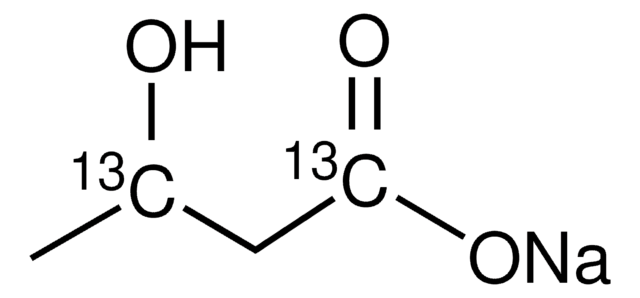Products may be shipped at a different temperature than the recommended long-term storage temperature. If the product quality is sensitive to short-term exposure to conditions other than the recommended long-term storage, it will be shipped on wet or dry-ice. If the product quality is NOT affected by short-term exposure to conditions other than the recommended long-term storage, it will be shipped at ambient temperature. As shipping routes are configured for minimum transit times, shipping at ambient temperature helps control shipping costs for our customers. For more information, please refer to the Storage and Transport Conditions document: https://www.sigmaaldrich.com/deepweb/assets/sigmaaldrich/marketing/global/documents/316/622/storage-transport-conditions-mk.pdf
166898
3-Hydroxybutyric acid
95%
Sinônimo(s):
(±)-3-Hydroxybutanoic acid, DL-β-Hydroxybutyric acid
About This Item
Produtos recomendados
Nível de qualidade
Ensaio
95%
Formulário
liquid
índice de refração
n20/D 1.443 (lit.)
p.e.
118-120 °C/2 mmHg (lit.)
solubilidade
ethanol: soluble 50 mg/mL, clear
densidade
1.126 g/mL at 25 °C
1.126 g/mL at 25 °C (lit.)
grupo funcional
carboxylic acid
hydroxyl
temperatura de armazenamento
2-8°C
cadeia de caracteres SMILES
CC(O)CC(O)=O
CC(O)CC(O)=O
InChI
1S/C4H8O3/c1-3(5)2-4(6)7/h3,5H,2H2,1H3,(H,6,7)
chave InChI
WHBMMWSBFZVSSR-UHFFFAOYSA-N
WHBMMWSBFZVSSR-UHFFFAOYSA-N
Procurando produtos similares? Visita Guia de comparação de produtos
Categorias relacionadas
Descrição geral
Aplicação
Aplicação
Palavra indicadora
Danger
Frases de perigo
Declarações de precaução
Classificações de perigo
Eye Dam. 1 - Skin Corr. 1B
Código de classe de armazenamento
8A - Combustible corrosive hazardous materials
Classe de risco de água (WGK)
WGK 3
Ponto de fulgor (°F)
233.6 °F - closed cup
Ponto de fulgor (°C)
112 °C - closed cup
Equipamento de proteção individual
Eyeshields, Gloves, type ABEK (EN14387) respirator filter
Escolha uma das versões mais recentes:
Já possui este produto?
Encontre a documentação dos produtos que você adquiriu recentemente na biblioteca de documentos.
Os clientes também visualizaram
Chromatograms
suitable for GC-
How is shipping temperature determined? And how is it related to the product storage temperature?
1 answer-
Helpful?
-
-
How can I determine the shelf life / expiration / retest date of this product?
1 answer-
If this product has an expiration or retest date, it will be shown on the Certificate of Analysis (COA, CofA). If there is no retest or expiration date listed on the product's COA, we do not have suitable stability data to determine a shelf life. For these products, the only date on the COA will be the release date; a retest, expiration, or use-by-date will not be displayed.
For all products, we recommend handling per defined conditions as printed in our product literature and website product descriptions. We recommend that products should be routinely inspected by customers to ensure they perform as expected.
For products without retest or expiration dates, our standard warranty of 1 year from the date of shipment is applicable.
For more information, please refer to the Product Dating Information document: https://www.sigmaaldrich.com/deepweb/assets/sigmaaldrich/marketing/global/documents/449/386/product-dating-information-mk.pdfHelpful?
-
-
3-ヒドロキシ酪酸は液体とのことですが,濃度はどれくらいになるのでしょうか?
1 answer-
This product is a neat or pure liquid and has not been diluted. The density of this material is 1.126 g/mL at 25 °C with a molecular weight of 104.1 daltons. The minimum purity of this product is 95%. The molarity of this product may range from 10.26 M at 95% to 10.8 M at 100%. Please refer to product Certificate of Analysis for the lot specific purity.
Helpful?
-
-
What's the solubility in paraffin oil?
1 answer-
Unfortunately, solubility information for Product 166898 in paraffin oil is unavailable. However, it is soluble in ethanol at 50 mg/mL.
Helpful?
-
Active Filters
Nossa equipe de cientistas tem experiência em todas as áreas de pesquisa, incluindo Life Sciences, ciência de materiais, síntese química, cromatografia, química analítica e muitas outras.
Entre em contato com a assistência técnica












